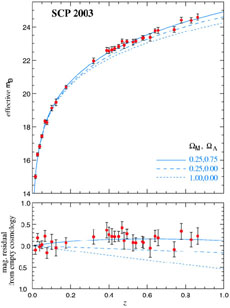


3.2. Supernovae and the Accelerating Universe
The great story of fin de siecle cosmology was the discovery that matter does not dominate the universe; we need some form of dark energy to explain a variety of observations. The first direct evidence for this finding came from studies using Type Ia supernovae as "standardizable candles," which we now examine. For more detailed discussion of both the observational situation and the attendant theoretical problems, see [48, 49, 8, 50, 51, 15].
Supernovae are rare - perhaps a few per century in a Milky-Way-sized galaxy - but modern telescopes allow observers to probe very deeply into small regions of the sky, covering a very large number of galaxies in a single observing run. Supernovae are also bright, and Type Ia's in particular all seem to be of nearly uniform intrinsic luminosity (absolute magnitude M ~ -19.5, typically comparable to the brightness of the entire host galaxy in which they appear) [52]. They can therefore be detected at high redshifts (z ~ 1), allowing in principle a good handle on cosmological effects [53, 54].
The fact that all SNe Ia are of similar intrinsic luminosities fits well with our understanding of these events as explosions which occur when a white dwarf, onto which mass is gradually accreting from a companion star, crosses the Chandrasekhar limit and explodes. (It should be noted that our understanding of supernova explosions is in a state of development, and theoretical models are not yet able to accurately reproduce all of the important features of the observed events. See [55, 56, 57] for some recent work.) The Chandrasekhar limit is a nearly-universal quantity, so it is not a surprise that the resulting explosions are of nearly-constant luminosity. However, there is still a scatter of approximately 40% in the peak brightness observed in nearby supernovae, which can presumably be traced to differences in the composition of the white dwarf atmospheres. Even if we could collect enough data that statistical errors could be reduced to a minimum, the existence of such an uncertainty would cast doubt on any attempts to study cosmology using SNe Ia as standard candles.
Fortunately, the observed differences in peak luminosities of SNe Ia are very closely correlated with observed differences in the shapes of their light curves: dimmer SNe decline more rapidly after maximum brightness, while brighter SNe decline more slowly [58, 59, 60]. There is thus a one-parameter family of events, and measuring the behavior of the light curve along with the apparent luminosity allows us to largely correct for the intrinsic differences in brightness, reducing the scatter from 40% to less than 15% - sufficient precision to distinguish between cosmological models. (It seems likely that the single parameter can be traced to the amount of 56Ni produced in the supernova explosion; more nickel implies both a higher peak luminosity and a higher temperature and thus opacity, leading to a slower decline. It would be an exaggeration, however, to claim that this behavior is well-understood theoretically.)
Following pioneering work reported in [61], two independent groups undertook searches for distant supernovae in order to measure cosmological parameters: the High-Z Supernova Team [62, 63, 64, 65, 66], and the Supernova Cosmology Project [67, 68, 69, 70]. A plot of redshift vs. corrected apparent magnitude from the original SCP data is shown in Figure 3.5.
 |
Figure 3.5. Hubble diagram from the Supernova Cosmology Project, as of 2003 [70]. |
The data are much better fit by a universe dominated by a cosmological
constant than by a flat matter-dominated model. In fact the
supernova results alone allow a substantial range of possible
values of
 M and
M and

 ;
however, if we
think we know something about one of these parameters, the other
will be tightly constrained. In particular, if
;
however, if we
think we know something about one of these parameters, the other
will be tightly constrained. In particular, if
 M ~ 0.3,
we obtain
M ~ 0.3,
we obtain
 |
(57) |
This corresponds to a vacuum energy density
 |
(58) |
Thus, the supernova studies have provided direct evidence for a nonzero value for Einstein's cosmological constant.
Given the significance of these results, it is natural to ask what level of confidence we should have in them. There are a number of potential sources of systematic error which have been considered by the two teams; see the original papers [63, 64, 69] for a thorough discussion. Most impressively, the universe implied by combining the supernova results with direct determinations of the matter density is spectacularly confirmed by measurements of the cosmic microwave background, as we discuss in the next section. Needless to say, however, it would be very useful to have a better understanding of both the theoretical basis for Type Ia luminosities, and experimental constraints on possible systematic errors. Future experiments, including a proposed satellite dedicated to supernova cosmology [71], will both help us improve our understanding of the physics of supernovae and allow a determination of the distance/redshift relation to sufficient precision to distinguish between the effects of a cosmological constant and those of more mundane astrophysical phenomena.